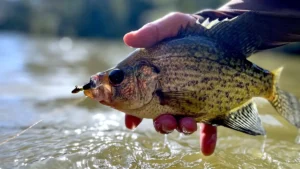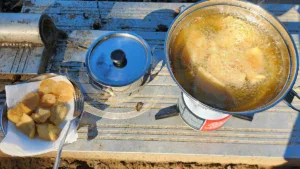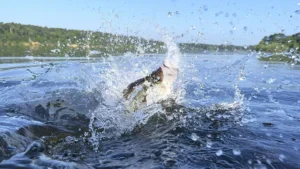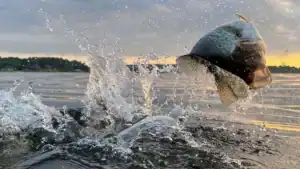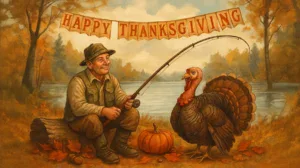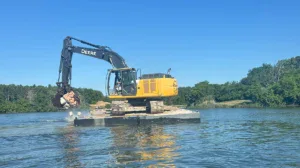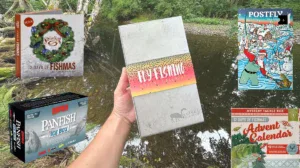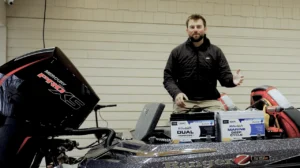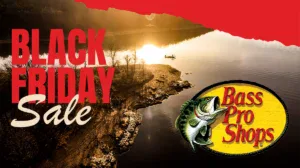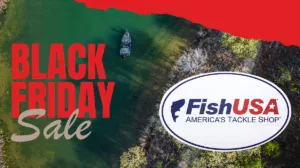It is no longer a secret that pulling crankbaits is a highly effective technique for tough-to-catch, warm-water crappie. Professional guides and tournament anglers lean heavily on this tactic during the summer months, due to both the consistency of the catch and the above-average size fish it produces.
While more every day anglers are utilizing this method, the perceived learning curve and amount of gear still scares off most anglers. Like most of our passions and hobbies, however, it can be as simple or as intricate as we wish to make it.
Professional guide Brad Whitehead spends the summer months taking eager clients out on Pickwick Lake in Northwest Alabama, and he prefers pulling crankbaits for big crappie because it produces fish.
Why to pull crankbaits
Pulling crankbaits enables the angler to cover a ton of water. With multiple baits covering a 30- to 40-foot swath at high speeds, locating schooling or nomadic crappie is much easier. Aside from the effectiveness of the tactic, pulling crankbaits also provides a constant breeze. With air temperatures reaching 90 degrees in the south by breakfast time, Whitehead dotes on the fact that moving at 1.5 mph keeps himself and his clients much cooler than if he were idly fishing deep brush. And finally wind won’t ruin the fishing with this technique.
When is the right time to pull crankbaits
During the sweltering summer months when oxygen levels are low and water temperature is high, crappie become lethargic and difficult to catch. So most anglers wonder why a big crankbait being pulled at 1.5 mph would be more effective.
Think of an old farm dog standing guard in front of his home on the side of the road. If you ease by him at a few miles per hour, he will merely observe you passing by. If you blow by him kicking up a cloud of dust and gravel, however, he will chase you with the ferocity of a lion after a gazelle. This inability of fish to resist the pursuit is what makes pulling crankbaits such a dynamic summertime tactic.

Gearing up
Anglers will find gear to be the biggest barrier to entry with this technique. While it can be done on a budget, there is a lot to consider. Depending on state regulations, anglers will need 2-8 rod and reel combos with 150 to 200 feet of line, an equivalent number of rod holders, a selection of crankbaits and a method of propulsion that will hold your boat on a steady path between 1 to 2 mph. You can buy the most effective equipment on the market, or you can start off as inexpensive as possible while learning and upgrade as you go.
- Terminal Tackle – Whitehead employs 10-pound Hi-vis Viscous line, tied to a No. 3 barrel swivel with a snap ring. The barrel swivel keeps the bait running true and minimizes line twist and the snap ring makes it easy to switch baits.
- Rods – The rods used for crankbaiting need to be tough with plenty of backbone, but also have a soft enough tip to give when a fish hits hard. Whitehead pulls 6 rods out of the back of the boat and uses the B’n’M Pro Staff Troller. The general rule of thumb is to keep 4 feet of separation between rod tips. Whitehead uses two each of 10-, 12- and 14-foot rods, and he gains another 2 feet of separation with rod angles. He prefers his rod tips close to the water so that his lure depth is consistent.
Budget cuts – Use old rods around the house at different lengths and angles to get started. Rods need to have a decent backbone to handle the torque of a trolled crank.
- Reels – Being that lure depth is achieved by boat speed combined with the length of line out, most anglers use reels with built in line-counters. Whitehead, however, guides on the same waters and consistently catches fish at two line lengths, 90 feet and 110 feet. Before each trip Whitehead measures out his line and marks a red mark at 90 feet and a blue mark at 110 feet with permanent markers. This allows him to use spinning reels, Quantum X30s to be exact. He does this to make it easier on his clients.
Budget cuts – Using Whitehead’s method of marking the line, any spinning or baitcast reels will work as long as they’ll hold 150-200 feet of 10-pound line and have solid gears and a decent drag.
- Rod Racks – Any sturdy rod rack will work for this technique. Rod holders should act as an extension of the boat and have no “wiggle” in them at all. Whitehead uses two Hi-Tek Stuff rod racks, each capable of holding up to 4 rods mounted on either side of the outboard.
Budget cuts – There are bolt-on and clamp-on rod holders as cheap as $3 or some anglers build their own. Just be aware you will inevitably get slammed by big catfish, gar, stripers. So make sure the rod holders are sturdy.
- Crankbaits – The crappie crankbait market is expanding but one brand really started the craze. The Bandit 300 series is the standard, and what 95% of anglers use, including Whitehead. Bandit’s pull straight consistently right out of the package.”They pull straight right out of the box, every time, period. I’ve pulled them until the paint wore off and they still ran just like they did when they were new,” Whitehead said. The best colors to use depend on where you fish, but anglers across the Midwest and south usually have some form of pink on at all times. Other popular colors are black and purple, crawfish, red and chartreuse and straight chartreuse.
Budget cuts – If you fish for bass you might have some old crankbaits that will work. To get to the right depth, they need to dive to 8-12 ft. To check, just find some clean bottom in varying depths and pull over it. You’ll know when it’s digging in the bottom, which tells you how deep it’s running with the amount of line out.
- Trolling equipment – The average speed is 1.5 mph and the average direction is straight, so this must be achieved while being able to manage poles and catch fish at the same time. Serious crankbaiters utilize MinnKota’s I-Pilot on an electric drive trolling motor. This technology allows the angler to set the speed and direction with a remote control from anywhere in the boat, leaving the fisherman to concentrate on fishing. Small kicker motors, or a 4-stroke outboard with a Happy Troller trolling plate can achieve this as well. But technology like Minn Kota’s Terrova and Ulterra with i-Pilot Link systems can integrate with your Humminbird graphs and follow map contours without angler intervention.
Budget cuts – Want to try pulling crankbaits but only have a big two-stroke outboard and a cable drive trolling motor? Most foot pedals have a set screw on the bottom that will tighten down, which will hold the trolling motor direction without having to keep a foot on it. Also, fingernail polish can be a great way to paint up some old crankbaits for crappie fishing.
Ideal crappie areas
Knowing where to employ the technique is as important as your gear selection. Here are a few places to begin your search.
- Ledges -“Crappie will move from main channels to flats from the post-spawn period all the way into late fall,” Whitehead said. A ledge is where the main channel runs along the flat and makes an edge underwater. The crappie will hold around stumps and cover on the edges of these drops from late spring to late fall.
- Deep Flats – This is Whitehead’s No. 1 location for finding numbers of crappie. Baitfish concentrate over these flats throughout the summer months, which attracts crappie. Whitehead likes 18- to 22-foot flats and fishes 12-16 feet deep. “I was in a helicopter above the Tennessee River once and was amazed at all the balls of baitfish I could see over the flats, most of them would have been impossible to see on a graph because they were so shallow,” Whitehead said.
- Main Channels – Crappie will sometimes suspend over main channels in the heart of the summer, usually found just a few feet above the thermocline. They stay close to that invisible line that separates the oxygenated water above from the less oxygenated water below. Crappie will seek cooler water but also need oxygenated water too.
- Over Structure – Many deep ledges will have very short, but wide stumps that are easy to fish over as long as you watch the depth. Pulling cranks over deep brush can be productive, but one mistake with a big pile will cost you a lot of crankbaits. So proceed with caution in areas with a lot of wood cover.
How to pull once you’re set up
Once you have the rods, reels, crankbaits and rod holders ready and way to troll the baits continuously as well as a place to start fishing, you need to start your trolling plan. Here are some tips to help you get started:
- Track a path – Start off by picking a path that will keep you in good water the longest, taking into account the wind and ability to turn around if need be. Remember, with multiple baits 100 feet behind the boat, there are no tight turns!
- Determine a depth – Like Whitehead, using 90 to 110 feet of line is a good starting point. At 1.5 mph this will put the 8- to 12-foot crankbaits between 12-16 feet, depending on wind on waves.
- Choose a speed – 1.5 to 1.7 mph is where Whitehead stays and is a common speed for pulling cranks. As anglers get more adept at the tactic, altering speed and line length will be tools they can employ.
- Stay current – If you’re in a lake without current, direction is only dictated by wind, and only if it’s strong enough to make running perpendicular to the waves difficult. While you may find that you get more bites heading sorth than south on a certain day, there are no specific rules here. When current is present, Whitehead likes to go into the flow. “I like to start at the back of the creek and go towards the main channel because that’s the natural flow of the water, but if the lake is rising, pushing water into the creeks, I’ll turn and work from the outside towards the back.”
Do you pull crankbaits for crappie? What other advice would you offer or questions do you have related to pulling crankbaits for crappie?





